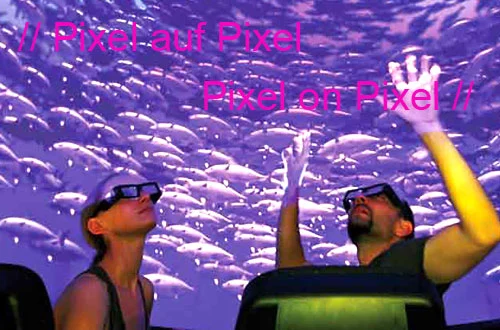Pixel on pixel
Glasses on, lights off, and the journey has started
Over the oceans with Darwin on the Beagle. The waves spray, and the swooping gulls virtually graze the tip of your nose – close enough to touch. The 3D dome cinema at Fraunhofer FIRST presents “Darwin’s mystery of mysteries” – a test show in the test dome. Here, the Fraunhofer Institute for Computer Architecture and Software Technology (FIRST) presents its latest developments in the automated calibration of projector clusters.
The particular charm of the dome: “Like in a planetarium, the hemispherical form covers the whole field of vision,” explained Manuel Schiewe of the Institute for Media Technology. However, it’s not quite so easy to project on curved surfaces like a dome, and not only because the images are distorted. A good resolution needs several projectors. Here in Adlershof there are sixteen. The difficulties involved can be seen when Schiewe runs the white idle images from each projector: the dome is fully illuminated by a crazed kaleidoscope of distorted squares that apparently overlap at random, four deep at some corners, giving rise to a particularly bright piece of imagery. This patchwork is needed to generate a cohesive overall picture. So that the observer of Beagle, Darwin, and Co notices nothing of this, a computer must not only distort the images from each projector accordingly, but also coordinate their superimpositions precisely to the pixel – their geometrical superimpositions, otherwise the images will be blurred or present double outlines. Yet also the brightness and chromaticity, not necessarily equal from projector to projector, must agree. For this purpose, the Fraunhofer researchers developed a flexible, and high speed automated calibration. The most important aids take the form of three cameras that cover the whole dome to the pixel precisely. Manuel Schiewe demonstrates the calibration process with test images of parallel vertical and horizontal lines. The software he has developed with his colleagues can then calculate the distortion of the image as a function of its current position, the position of the projectors, and a virtual model of the affected surface – including the overlap calculated precisely to the pixel. The images provided by the cameras are also analysed to equalise the brightness values. In order to determine chromaticity, the researchers resorted to spectrometers that detect the individual nuances when passing over colour scales. The whole process takes just a few minutes and is possible with standard projectors, cameras, and computers. Multiprojectors of this kind are not only reserved for cinemas and planetariums, many of which are presently converting to digital technology in cooperation projects with Carl Zeiss AG. According to Schiewe, shaped surfaces are also a favourite for presentations at trade fair stands. And the better coverage this technology provides for the field of vision should also appeal to driving and flight simulators.
by Uta Deffke
Link: www.first.fraunhofer.de
